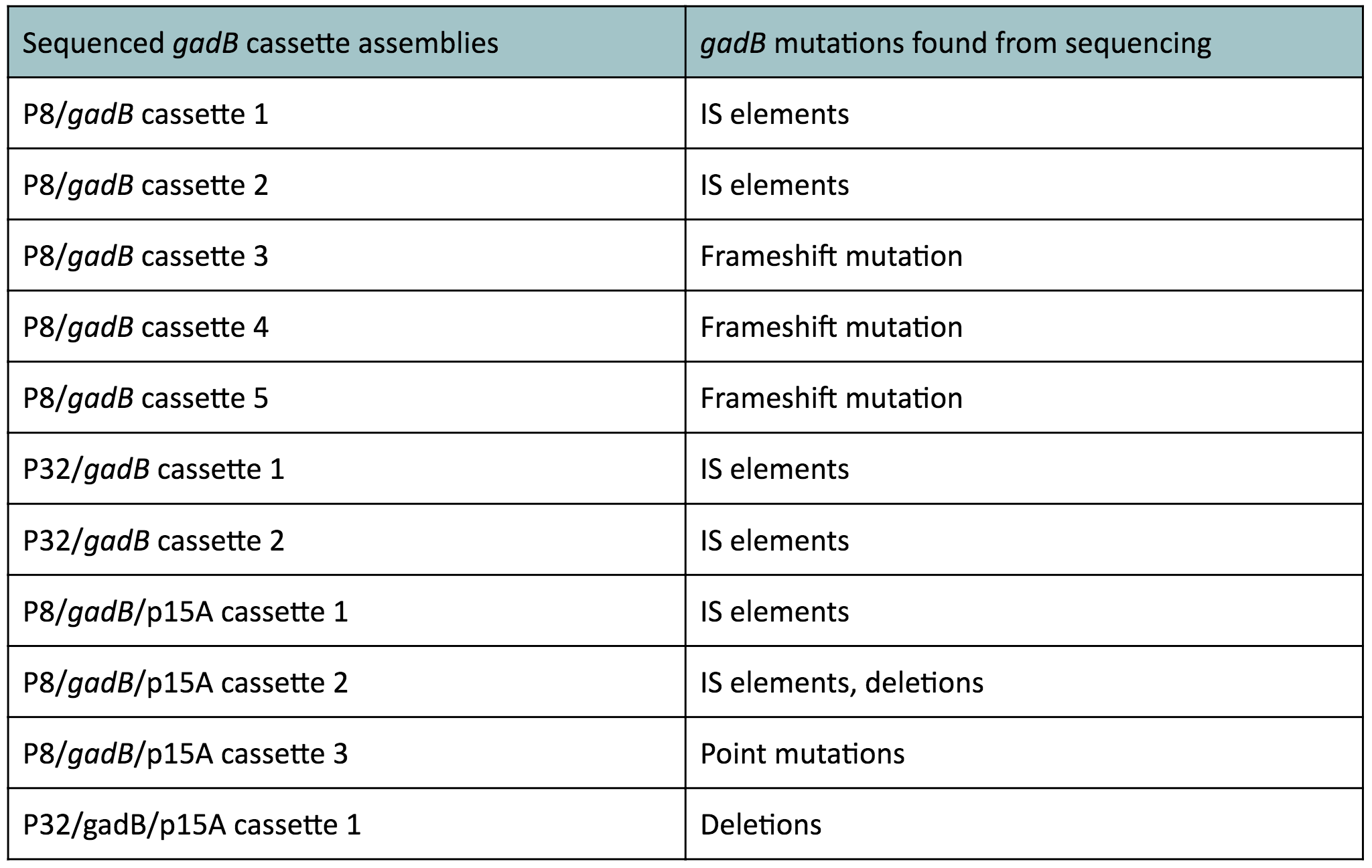| Line 17: | Line 17: | ||
<h2> Demonstrate </h2> | <h2> Demonstrate </h2> | ||
| − | <p> From our experiments attempting to increase <i>gadB</i> expression as a way to increase GABA production in bacteria, it was evident that constitutive expression of the <i>gadB</i> gene led to its rapid mutational degradation. <b>It is most likely that our cassette transformants were able to overexpress the <i>gadB</i> gene.</b> However, <i>gadB</i> overexpression was metabolically-taxing to these cells, as the glutamate typically used for important cellular growth processes was being allocated towards GABA production, which was a process that did not confer a selective advantage. As a result, subsequent generations of these cells initially overexpressing <i>gadB</i> began to "break" the <i>gadB</i> gene. After several generations, the colonies that appeared on our plates represented only the clones containing the mutationally degraded <i>gadB</i> gene. These cells were selectively favored in the population, as having a broken <i>gadB</i> gene allowed them to utilize glutamate sources for growth processes, providing a competitive advantage over other cells containing the functional, metabolically-burdensome <i>gadB</i> gene. <b>Observed mutations of the <i>gadB</i> gene in our cassette assemblies, which can be seen in <b>Table 1</b> below, | + | <p> From our experiments attempting to increase <i>gadB</i> expression as a way to increase GABA production in bacteria, it was evident that constitutive expression of the <i>gadB</i> gene led to its rapid mutational degradation. <b>It is most likely that our cassette transformants were able to overexpress the <i>gadB</i> gene.</b> However, <i>gadB</i> overexpression was metabolically-taxing to these cells, as the glutamate typically used for important cellular growth processes was being allocated towards GABA production, which was a process that did not confer a selective advantage. As a result, subsequent generations of these cells initially overexpressing <i>gadB</i> began to "break" the <i>gadB</i> gene. After several generations, the colonies that appeared on our plates represented only the clones containing the mutationally degraded <i>gadB</i> gene. These cells were selectively favored in the population, as having a broken <i>gadB</i> gene allowed them to utilize glutamate sources for growth processes, providing a competitive advantage over other cells containing the functional, metabolically-burdensome <i>gadB</i> gene. <b>Observed mutations of the <i>gadB</i> gene in our cassette assemblies, which can be seen in <b>Table 1</b> below, demonstrates its intial overepxression in the original population of transformants followed by its mutational degradation in subsequent surviving generations.</b></p> |
Revision as of 15:07, 1 November 2017
Demonstrate
From our experiments attempting to increase gadB expression as a way to increase GABA production in bacteria, it was evident that constitutive expression of the gadB gene led to its rapid mutational degradation. It is most likely that our cassette transformants were able to overexpress the gadB gene. However, gadB overexpression was metabolically-taxing to these cells, as the glutamate typically used for important cellular growth processes was being allocated towards GABA production, which was a process that did not confer a selective advantage. As a result, subsequent generations of these cells initially overexpressing gadB began to "break" the gadB gene. After several generations, the colonies that appeared on our plates represented only the clones containing the mutationally degraded gadB gene. These cells were selectively favored in the population, as having a broken gadB gene allowed them to utilize glutamate sources for growth processes, providing a competitive advantage over other cells containing the functional, metabolically-burdensome gadB gene. Observed mutations of the gadB gene in our cassette assemblies, which can be seen in Table 1 below, demonstrates its intial overepxression in the original population of transformants followed by its mutational degradation in subsequent surviving generations.


